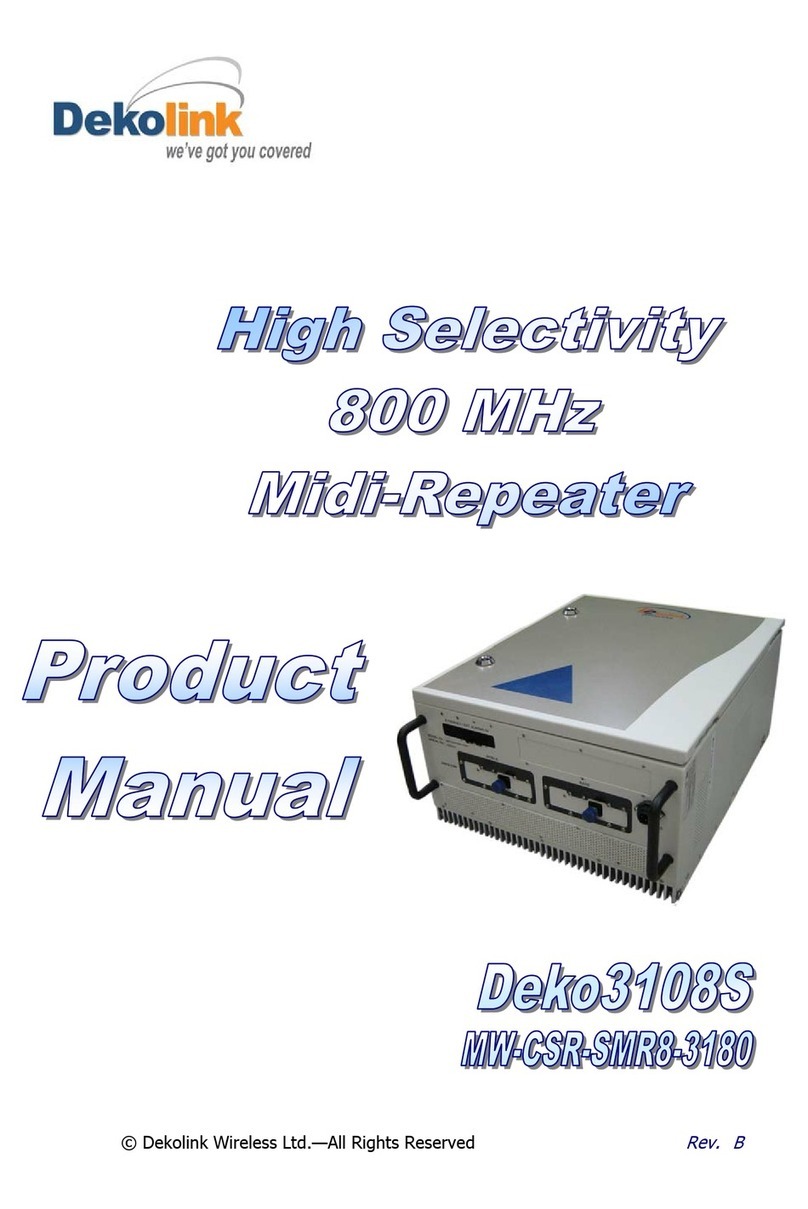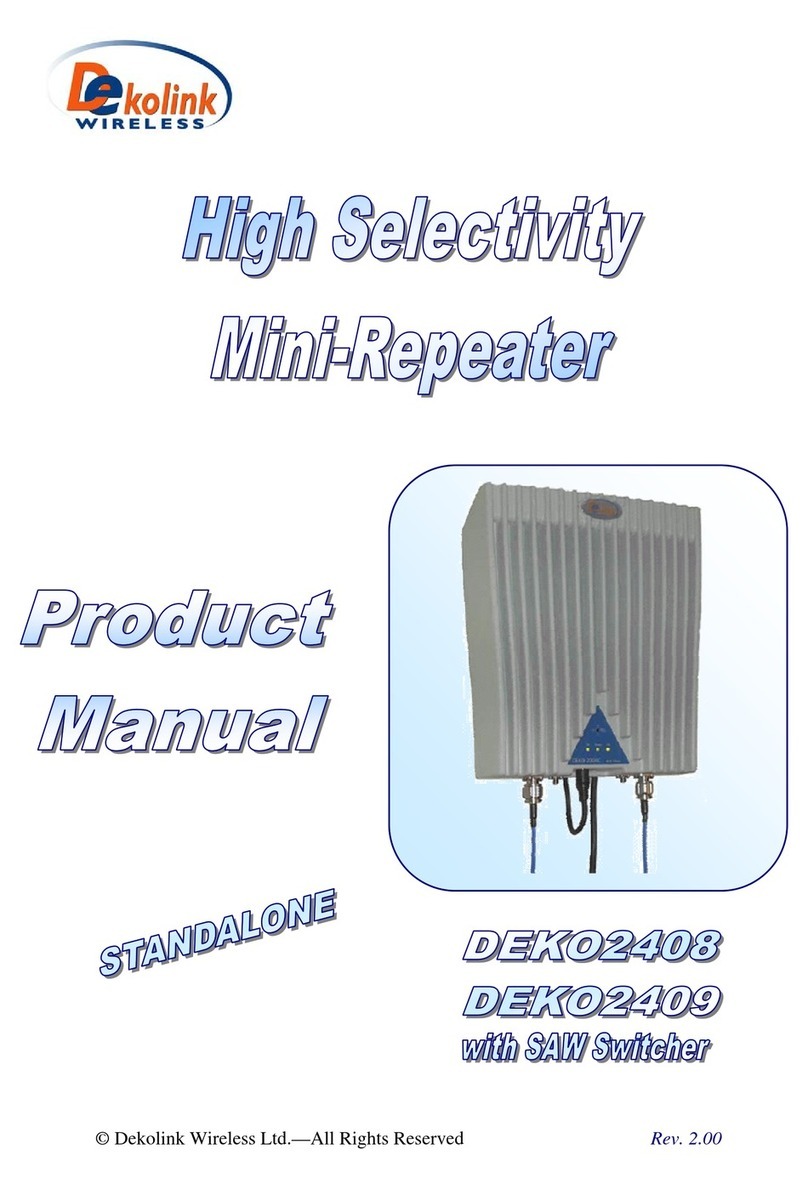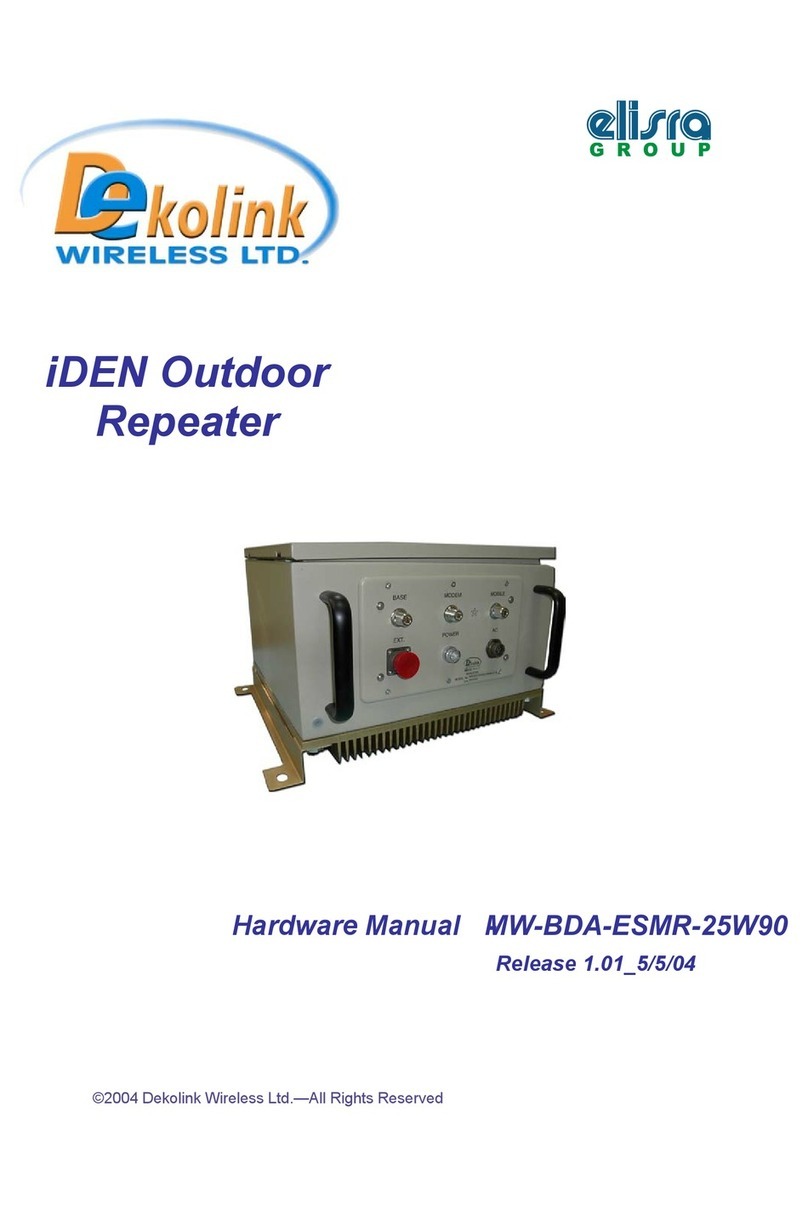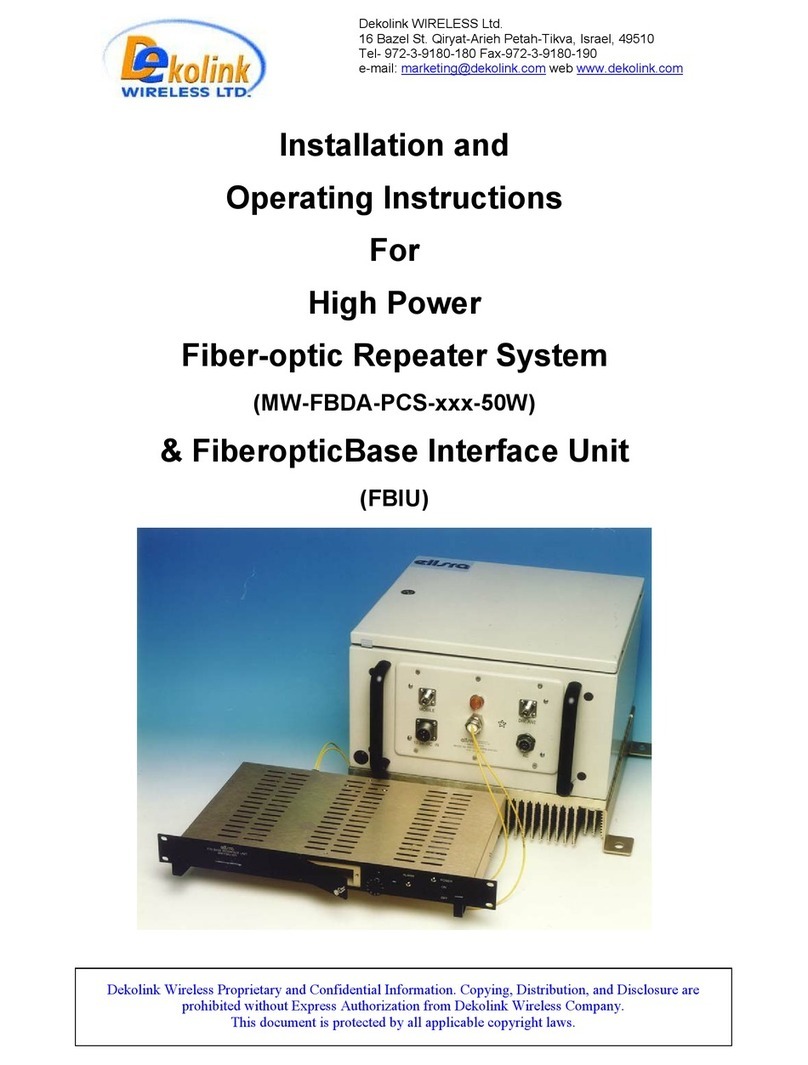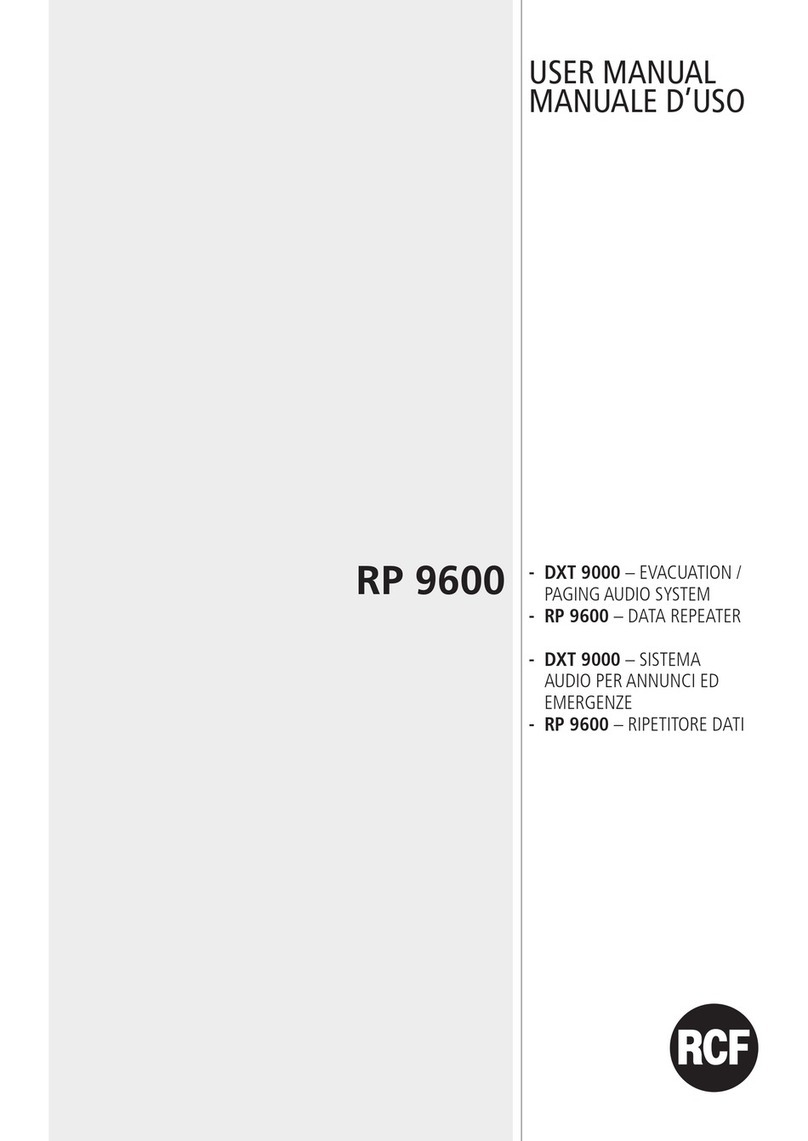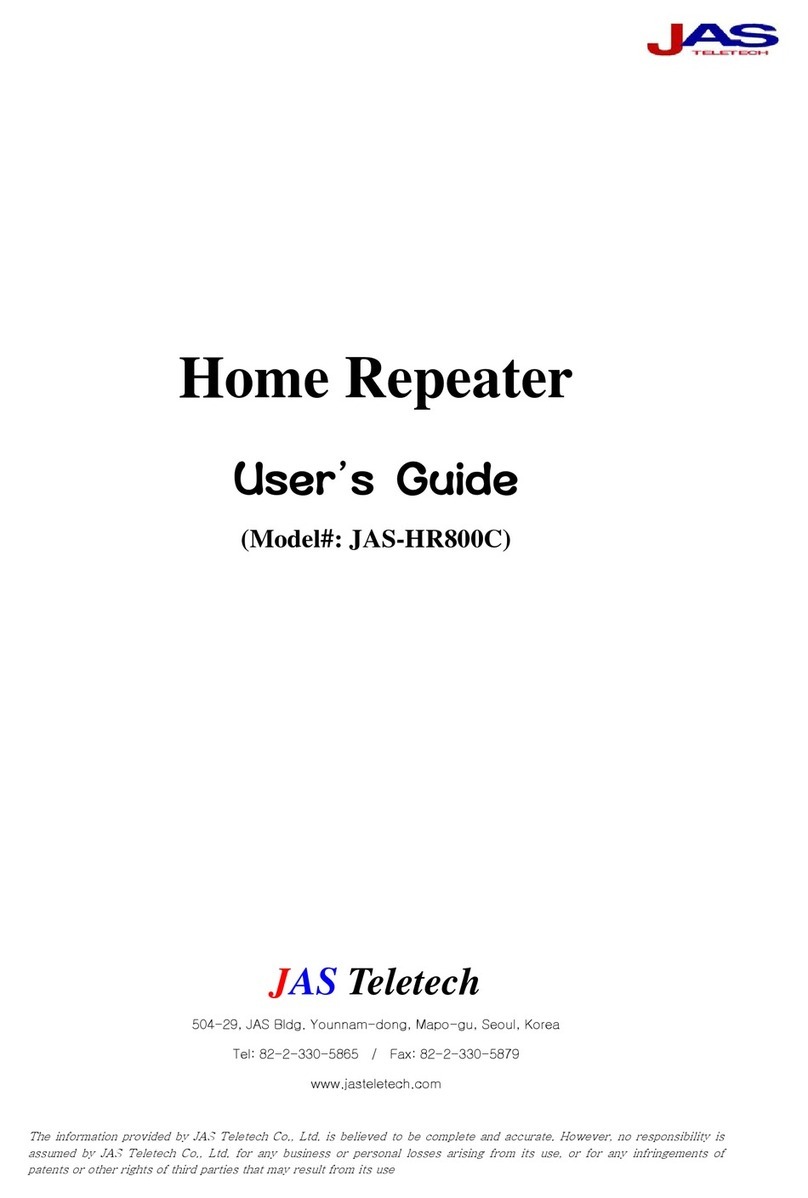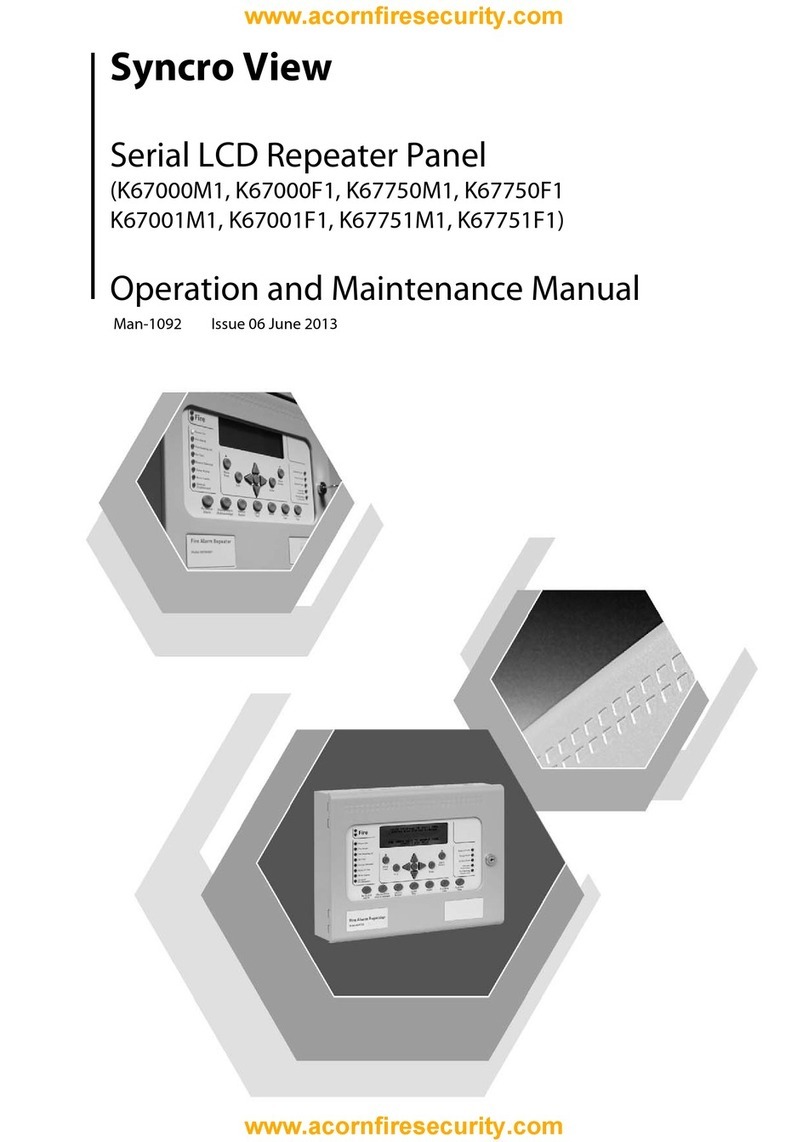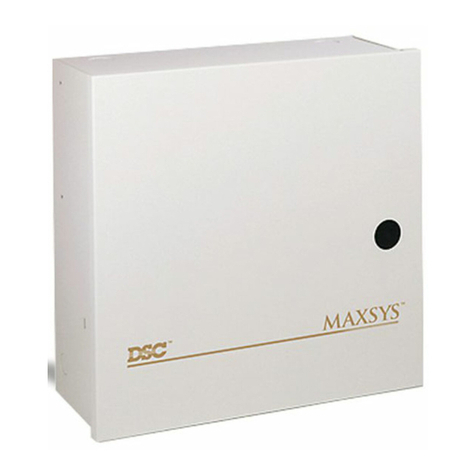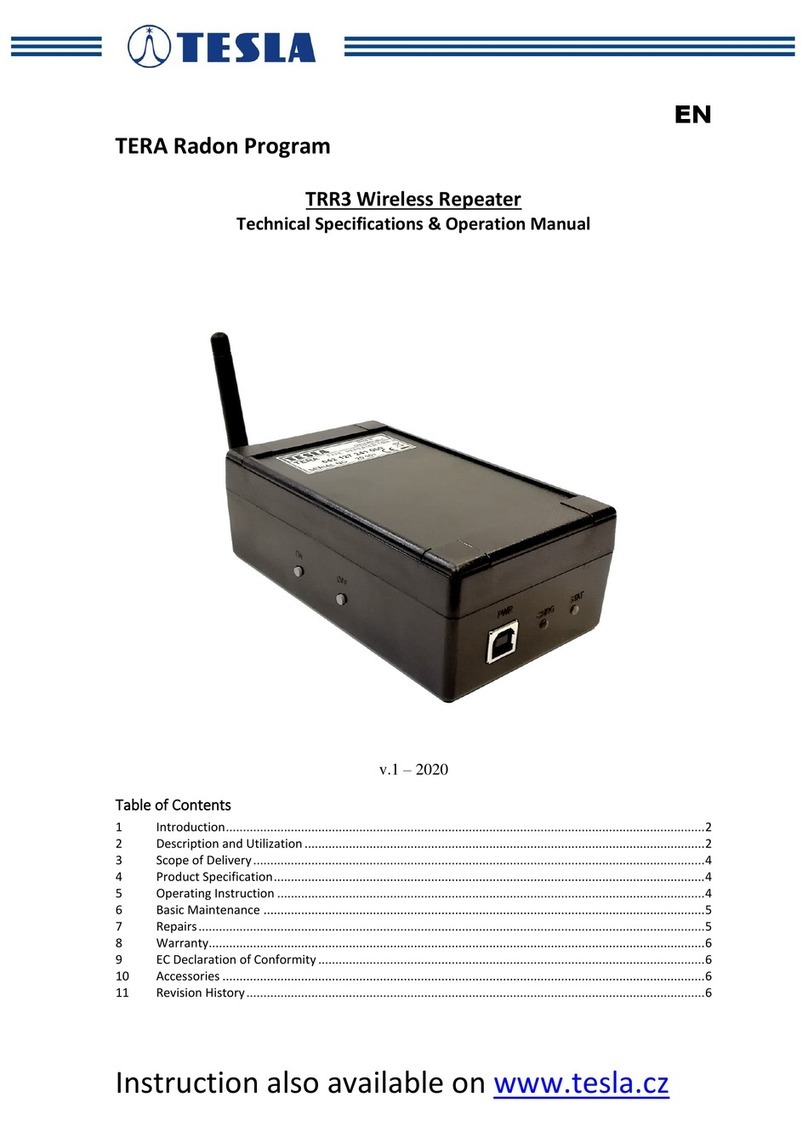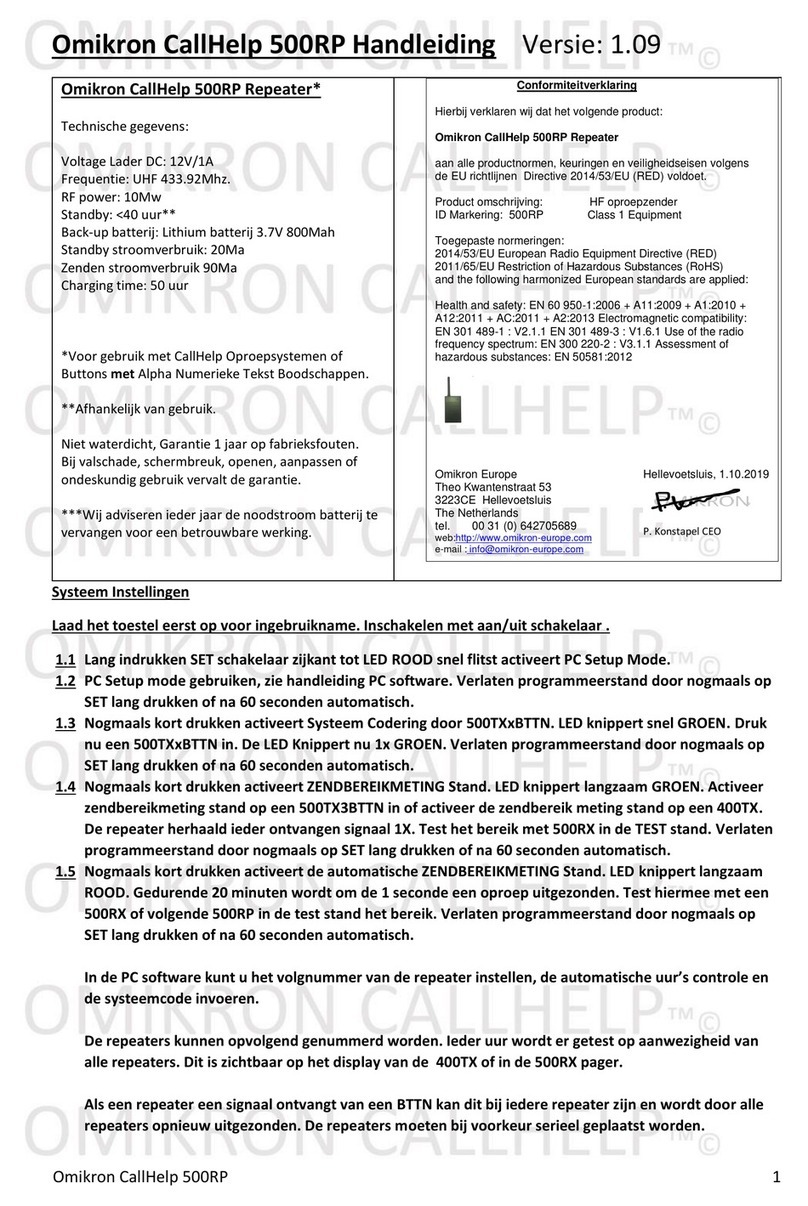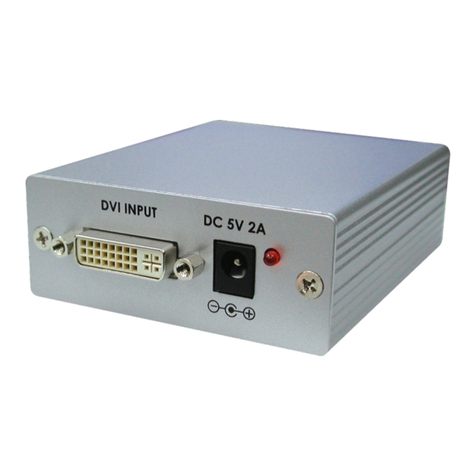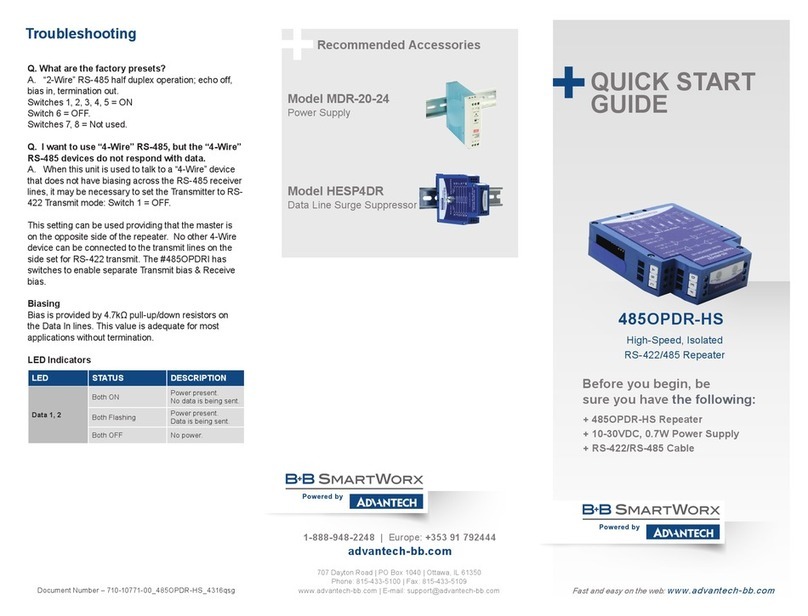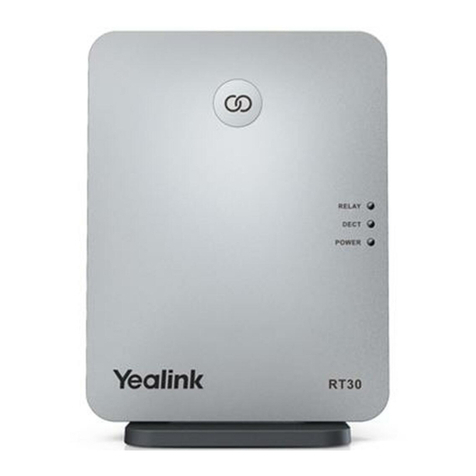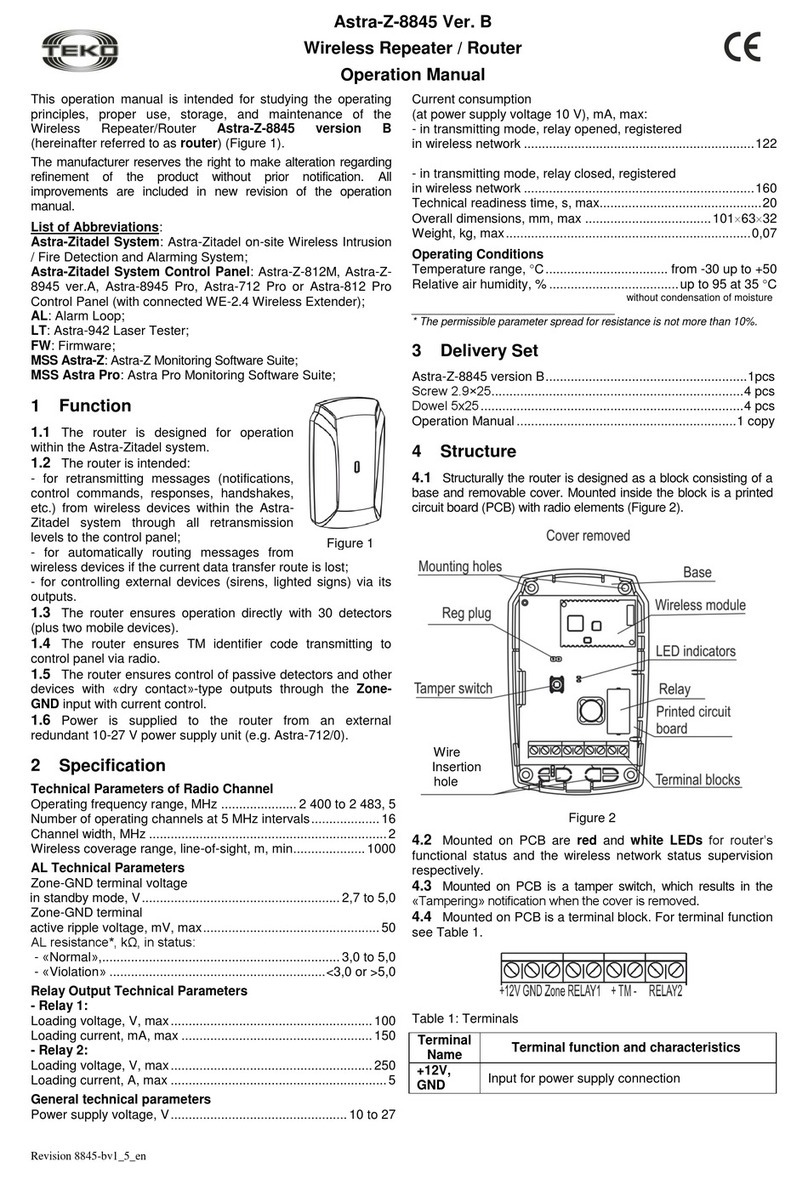Dekolink Deko2119 User manual

© Dekolink Wireless Ltd.—All Rights Reserved Rev. 2.01


ABOUT THIS MANUAL
This Product Manual provides the following information:
•Description of the Mini-Repeater
•Procedures for setup, configuration and checking the proper operation of
the Mini-Repeater
•Maintenance and troubleshooting procedures
TO WHOM IT IS INTENDED:
This Product Manual is intended for experienced technicians and engineers. It is
assumed that the customers installing, operating, and maintaining Dekolink Mini-
Repeaters are familiar with the basic functionality of Repeaters.
NOTICE Confidential - Authorized Customer Use
This document may be used in its complete form only and is solely for the use of
Dekolink Wireless Ltd. employees and authorized Dekolink Wireless Ltd. channels
or customers. The material herein is proprietary to Dekolink Wireless Ltd. Any
unauthorized reproduction, use or disclosure of any part thereof is strictly
prohibited.
All trademarks and registered trademarks are the property of their respective
owners.
DISCLAIMER OF LIABILITY
Contents herein are current as of the date of publication. Dekolink Wireless Ltd.
reserves the right to change the contents without prior notice. The information
furnished by Dekolink Wireless Ltd. in this document is believed to be accurate
and reliable. However, Dekolink Wireless Ltd. assumes no responsibility for its
use. In no event shall Dekolink Wireless Ltd. be liable for any damage resulting
from loss of data, loss of use, or loss of profits and Dekolink Wireless Ltd. further
disclaims any and all liability for indirect, incidental, special, consequential or
other similes damages. This disclaimer of liability applies to all products,
publications and services during and after the warranty period.
EXCLUSIVE REMEDIES
The remedies provided herein are the Buyer’s sole and exclusive remedies.
Dekolink Wireless Ltd. shall not be viable for any direct, incidental, or
consequential damages, whether based on contract, tort, or any legal theory.
Dekolink Wireless
International Headquarters
16 Bazel St., Kiryat-Arieh,
Petah-Tikvah 49001
ISRAEL
Tel.: +972 3 918-0180
Fax: +972 3 918-0190
E-mail: marketing@dekolink.com
Website: www.dekolink.com
Dekolink USA, Inc.
Americas Group
550 Club Drive
Ste. 470
Montgomery, Texas 77316-3094, USA
Tel: +1-936-582-7100
Fax: +1- 936-582-7108
Website: www.dekolink.com
© Dekolink Wireless Ltd
Publication No.: 313-2006 Rev. 2.01S

Page b Proprietary Data Pub. 308-2005 Rev. 2.00S
SAFETY WARNINGS AND ADMONISHMENTS
Throughout this manual, important safety warnings and admonishments are included to
warn of possible hazards to persons or equipment. A safety warning identifies a possible
hazard and then describes what may happen if the hazard is not avoided. The safety
warnings – in the form of Dangers, Warnings and Cautions must be followed at all times.
These warnings are flagged by the use of a warning icon, usually the triangular alert icon
seen below. The exclamation point within the triangular alert icon is intended to warn the
operator or service personnel of operation and maintenance from factors elating to the
product and its operating environment, which could pose a safety hazard.
GENERAL SAFETY WARNINGS CONCERNING USE OF THIS SYSTEM
Always observe standard safety precautions during installation, operation and
maintenance of this product. Only a qualified and authorized personnel should carry out
adjustment, maintenance or repairs to the components of this equipment.
Danger: Electrical Shock
This equipment is intended to be installed indoor. Wet conditions increase the
potential for receiving an electric shock when installing or using electrically
powered equipment. To prevent electrical shock when installing or modifying
the system power wiring, disconnect the wiring at the power source before
working with uninsulated wires or terminals.
Caution: RF Exposure
Installation of an antenna must comply with the FCC RF exposure
requirements. See paragraph 4.9.

PRODUCT MANUAL MINI-REPEATER DEKO2119 DEKOLINK WIRELESS LTD.
Pub. 313-2006 Rev. 2.01S Proprietary Data Page c
GLOSSARY The following is a list of abbreviations and terms used throughout this document.
Abbreviation/Term Definition
AGC Automatic Gain Control
ALC Automatic Level Control
AMP (P_amp) Amplifier (power amplifier)
ATR Acceptance Test Results
BTS Base Transceiver Station
DAS Distributed Antenna System
DL Downlink
Downlink The path covered from the Base Transceiver
Station (BTS) to the subscribers/service area
via the Repeater
ESD Electro-Static Discharge
IF Intermediate Frequency
MN Model Number
NMT Network Management Tool
PCS Personal Communications Service
PLL Phased Locked Loop
RF Radio Frequency
RMS Repeater Management System
SALC Smart-ALC (Automatic Level Control)
SIM Subscriber Identification Module
SQE Signal Quality Estimate
UL Uplink
Uplink The path covered from the subscribers/service
area to the Base Transceiver Station (BTS)
via the Repeater
VSWR Voltage Standing Wave Ratio


DEKOLINK WIRELESS LTD. MINI-REPEATER DEKO2119 PRODUCT MANUAL
Pub. 313-2006 Rev. 2.01S Proprietary Data Page i
CONTENTS
1. INTRODUCTION..................................................................................... 1
1.1 General........................................................................................................................ 1
1.2 Applications................................................................................................................. 1
1.3 Main Features.............................................................................................................. 2
1.4 Description .................................................................................................................. 2
1.5 Controls and Indicators............................................................................................... 3
1.6 Model and Frequencies................................................................................................ 5
1.7 Unpacking and Inspection............................................................................................ 6
2. FUNCTIONAL DESCRIPTION................................................................ 7
2.1 General........................................................................................................................ 7
3. SPECIFICATIONS................................................................................... 9
3.1 General........................................................................................................................ 9
3.2 Electrical Specifications............................................................................................... 9
3.3 General Specifications ................................................................................................. 9
3.4 Mechanical Specifications.......................................................................................... 10
3.5 Environmental Specifications..................................................................................... 10
3.6 Connectors ................................................................................................................ 11
4. INSTALLATION AND OPERATION..................................................... 12
4.1 General...................................................................................................................... 12
4.2 Safety Instructions..................................................................................................... 12
4.3 Installation Site Considerations ................................................................................. 12
4.4 Tools and Materials................................................................................................... 12
4.5 Installation Procedures.............................................................................................. 12
4.6 Antenna Installation Site – Considerations................................................................. 14
4.7 Connection to Antennas and to Power........................................................................ 14
4.8 Operating Procedures................................................................................................ 15
4.9 Donor Antenna Alignment......................................................................................... 16
4.10 RF Exposure Warning............................................................................................. 17
5. DUAL-BAND MINI-REPEATERS CONFIGURATION.......................... 18
6. DAISY-CHAINED DUAL-BAND MINI-REPEATERS............................ 19
7. SETUP (monitoring and control)............................................................. 20
7.1 General...................................................................................................................... 20
7.2 Local Mode Connection............................................................................................. 20
7.3 Repeater Management System (RMS)........................................................................ 21
7.4 RMS650 – Main Screen Description........................................................................... 23
7.5 Selecting Deko2119.................................................................................................... 24
7.6 RMS 650 Screens Operation...................................................................................... 27
7.7 Selecting the Operating Sub-Bands............................................................................ 30
7.8 Finalizing the Operation Procedures.......................................................................... 34
7.9 Alarms Screen ........................................................................................................... 35
7.10 Configuration Screen............................................................................................... 36
7.11 Exiting the RMS Software........................................................................................ 37

PRODUCT MANUAL MINI-REPEATER DEKO2119 DEKOLINK WIRELESS LTD.
Page ii Proprietary Data Pub. 313-2006 Rev. 2.01S
8. MAINTENANCE AND TROUBLESHOOTING...................................... 38
8.1 General ......................................................................................................................38
8.2 Periodic Maintenance.................................................................................................38
8.3 Failure Display...........................................................................................................38
8.4 Status LEDs Troubleshooting.....................................................................................38
8.5 Mini-Repeater Alarms and Troubleshooting...............................................................40
8.6 Dry-Contact Alarms...................................................................................................44
Appendix A: Dekolink Wireless Limited Warranty ..................................... 45

DEKOLINK WIRELESS LTD. MINI-REPEATER DEKO2119 PRODUCT MANUAL
Pub. 313-2006 Rev. 2.01S Proprietary Data Page 1
1. INTRODUCTION
1.1 GENERAL
Mini-Repeater Deko2119 is a PCS Block Selective RF Mini-Repeater that
amplifies signals bi-directionally between base stations and mobile handsets, in
cellular and other wireless systems (see Figure 1).
Deko2119 provides high selectivity capability by employing an advanced
up/down conversion and Intermediate Frequency (IF) SAW filtering
architecture.
This product features the Smart ALC algorithm that provides "plug-and-play"
capability for fast response and immediate solution to your coverage needs,
while preventing degradation in network performance. This repeater is provided
with a SAW Switcher that can be configured with pre-determined different
frequency blocks so as to enable complex frequency plans, as well as providing
two units in one Repeater.
Mini-Repeater Deko2119 is provided with 80 dB gain as default. Some units
are configured with 70 dB gain only. This manual is valid for both
configurations.
In addition, Deko2119 features a special configuration for dual-band coverage
using a Combiner. It enables interconnecting with another Mini-Repeater, such
as Deko2408, to provide coverage in the Deko2119 bandwidth as well as for
CDMA by Deko2408. The dual-band combination supports a single
Distribution Antenna System to provide coverage by different providers.
Deko2119 fully meets the FCC standard requirements.
1.2 APPLICATIONS
Dekolink’s Mini-Repeaters are suitable for deployment in dense urban
environments, tunnels and other areas where physical structures cause low
cellular coverage.
The Mini-Repeater introduces new system capabilities that enable a wide
variety of applications particularly when adjacent band selectivity and/or very
high spectral purity are required. This repeater provides a solution to situations
in which flexible, high quality and high resolution filtering methods are
necessary.
Dekolink’s Mini-Repeaters help improve in-building coverage, as the driver for
a single antenna for spot coverage or a distributed antenna system (DAS) for
larger coverage areas.

PRODUCT MANUAL MINI-REPEATER DEKO2119 DEKOLINK WIRELESS LTD.
Page 2 Proprietary Data Pub. 313-2006 Rev. 2.01S
1.3 MAIN FEATURES
Some of the Deko2119 PCS Mini-Repeater features are listed below:
•1/8 W (+21 dBm) Uplink and Downlink composite power
•82 dB RF gain
•Highly linear amplification
•Excellent out-of-band interference prevention
•Tunable sharp cutoff IF SAW filters
•High spectral purity
•SAW Switcher capability
•Unique microprocessor controlled features:
oRemote or local control and alarms (software enabled)
option
oSmart ALC, for in-network transparent operation
oBuilt-in power measurement and RSSI indication.
•Excellent power to volume ratio
•Boasts a stylish design for indoor installation, and can be easily
installed on a wall or on a pole.
1.4 DESCRIPTION
1.4.1 General
This paragraph provides a brief description of key functional capabilities of
Mini-Repeater Deko2119.
1.4.2 Switchable Bandwidth
The internal SAW Switcher enables to implement the Switchable Bandwidth
option. This function enables more efficient and better adaptability of the
Repeater to your needs. This capability enables you to install the Repeater in
different operation environments or adapt it to the evolving operating
environment.
In standard configuration, the Switchable Bandwidth function provides the
capability to set up to three pre-determined different frequency blocks of 5, 10
and 15 MHz bandwidth respectively, as per requirement. The operating center
frequency is user-adjustable anywhere within the PCS band.
This capability ensures that in case of bandwidth evolution at the installation
site, you are not required to replace the installed Repeater, just set the second
bandwidth.
1.4.3 Smart-ALC
The downlink path includes Dekolink’s Smart Automatic Level Control
(Smart-ALC) control algorithm to ensure linear operation of the Repeater. This
feature automatically adjusts the Repeater gain, reducing it in case of over the
limit power output, or boosting it to maintain maximum gain utilization.
The Smart-ALC automatically maintains downlink and uplink gain balance.
This capability keeps system transparency at all times and enables "cell

DEKOLINK WIRELESS LTD. MINI-REPEATER DEKO2119 PRODUCT MANUAL
Pub. 313-2006 Rev. 2.01S Proprietary Data Page 3
shrinking" whenever applicable. This algorithm is intended to prevent
oscillation in case of insufficient isolation.
In CDMA and UMTS networks, this optimum gain setting ensures the repeater
is transparent in the network and allows the repeater coverage area to “breathe”
along with the main cell coverage.
1.4.4 Operating Modes
Mini-Repeater Deko2119 can be operated in two modes:
•Manually, by a power control selector and LED indicators.
•Software control, via RS-232
1.4.5 Dual-Band Configuration
The Deko2119 can be operated in a dual-band configuration with a DEKO2408
Mini-Repeater. This configuration supports a single Distribution Antenna
System (DAS) to enable dual coverage of the PCS range (by Deko2119) and
the Cellular range by Deko2408.
Deko2119 includes a special purpose diplexer at the input and output interfaces
to enable the dual-band interconnection.
1.5 CONTROLS AND INDICATORS
The Block Selective Mini-Repeater includes one power adjustment selector and
three status LEDs in its front panel (see Figure 2).
1.5.1 Power Selector
The power selector enables to set the maximum output power in accordance
with the coverage design requirements, during the setup and during
troubleshooting of the Repeater.
Figure 1: Mini-Repeater Deko2119

PRODUCT MANUAL MINI-REPEATER DEKO2119 DEKOLINK WIRELESS LTD.
Page 4 Proprietary Data Pub. 313-2006 Rev. 2.01S
1.5.2 Status LEDS
The status LEDs provide indication on the Repeater operation (see Figure 2 and
refer to Table 1):
At turn on, the LEDs show the built-in test procedures: the LEDs turn from
orange to red to green.
Figure 2: Mini-Repeater Indicators Panel
Table 1 – Mini-Repeater LEDs Function
LED DESCRIPTION FUNCTION FUNCTIONAL DISPLAY
Green Red Orange Blinking
Green
DL Downlink Downlink
path status
indication
Normal
operation Major
malfunction High input
power Low power
transmission
Power Power \ Major
alarms status
indication
Normal
operation Major
malfunction (Blinking)
Panel Mask *
---
UL Uplink Uplink path
status
indication
Normal
operation Major
malfunction High input
power ---
* Power Selector disabled
Refer to Chapter 8 for a description of the alarms and their interpretation.

DEKOLINK WIRELESS LTD. MINI-REPEATER DEKO2119 PRODUCT MANUAL
Pub. 313-2006 Rev. 2.01S Proprietary Data Page 5
1.6 MODEL AND FREQUENCIES
Dekolink’s Block Selective Mini-Repeater can be provided in several models,
as listed below.
The operating frequency ranges depend on the type and model, as follows:
Standard configuration, single block: MW-CCSR-PCS-1W80-5-10-15
PCS Mini-Repeater Deko2119 can also be provided in a variety of configurations,
with up to three non contiguous blocks, as described in the following examples.
In these cases, the Model Number includes the following information:
MW-CCSR-PCS-1W80-xx-Sxy-yy-Syz-zz
Where:
MW-CCSR-PCS-1W80 represents the PCS Mini-Repeater Deko2119,
and
xx is the first block
yy is the second block
xy is the separation between the first two blocks and
yz is the separation between the second block and the third one
All values are in MHz, unnecessary values are omitted
For example:
Deko2119 with D and E blocks shall be designated as:
MW-CCSR-PCS-1W80-05-S15-05.
Deko2119 with A and E blocks shall be designated as:
MW-CCSR-PCS-1W80-15-S20-05.
Older versions are provided with 70 dB gain. Their Model number is:
MW-CCSR-PCS-1W70-xx-Sxy-yy-Syz-zz for its different
configurations.

PRODUCT MANUAL MINI-REPEATER DEKO2119 DEKOLINK WIRELESS LTD.
Page 6 Proprietary Data Pub. 313-2006 Rev. 2.01S
1.7 UNPACKING AND INSPECTION
This section provides information for unpacking and inspection:
•Examine the shipping container for damage before unpacking the unit.
Perform a visual inspection to reveal any physical damage to the
equipment.
•Verify that the equipment is complete, as listed below. Contact
Dekolink Wireless Ltd if any of this equipment is missing.
Your Mini-Repeater comes with the following equipment:
•Mini-Repeater
•AC cable [6 ft.]
•RS232 Female to Female cable
•Mini-Repeater Product Manual
•RMS Software Installation CD
•Acceptance Test Results (A.T.R.)
•Packaging Box

DEKOLINK WIRELESS LTD. MINI-REPEATER DEKO2119 PRODUCT MANUAL
Pub. 313-2006 Rev. 2.01S Proprietary Data Page 7
2. FUNCTIONAL DESCRIPTION
2.1 GENERAL
The Block Selective Mini-Repeater functional operation is based on a duplexed
path configuration. In each path, the signal is down-converted to an
Intermediate Frequency (IF); filtered by a Surface Acoustic Wave (SAW) filter
and up-converted back. This configuration gives sharp out of band attenuation
for improved system performance.
2.2 FUNCTIONAL DESCRIPTION
2.2.1 Signal Path
The following process is performed in both the Uplink and Downlink paths of
the Repeater (see Figure 3).
The incoming RF signal from either the Base antenna (from the BTS) or from
the Mobile antenna (from the mobile handset) enters the Repeater through a
diplexer that enables dual-band support. The signal is filtered by the Duplexer,
followed by an Automatic Gain Control (AGC) amplifier (AMP). The signal is
then down-converted to an Intermediate Frequency (IF).
Figure 3: Mini-Repeater - Block Diagram
The IF signal is further filtered by a Surface Acoustic Wave (SAW) filter. The
Mini-Repeater includes three selectable SAW filters. However, a single filter
can be activated at any time. The IF signal is then converted back to RF signal
by the Up-Converter. This processing path provides sharp out-of-band
attenuation that improves the isolation between the receiving and transmitting
paths.

PRODUCT MANUAL MINI-REPEATER DEKO2119 DEKOLINK WIRELESS LTD.
Page 8 Proprietary Data Pub. 313-2006 Rev. 2.01S
The output RF signal is amplified by a power amplifier, combined by the
Duplexer and output from the diplexer that enables dual-band (Cellular and
PCS) signal output.
2.2.2 Power Monitoring - Smart-ALC
The Smart Automatic Level Control (Smart-ALC) is an innovative algorithm
for automatic repeater gain adjustment. Combined with advanced control
algorithms, SALC can perform gradual learning of traffic load characteristics
and adjust the Repeater RF Gain to the desired value.
This automatic operation practically removes the need to make initial settings
for maximal traffic load conditions and eliminates the need for numerous site
visits to take care of Gain adjustment.
The Smart-ALC maintains the Uplink/Downlink gain balance for system
transparency. This algorithm also adjusts the gain of the Repeater paths in case
of oscillations that may occur due to insufficient isolation, thus preventing
oscillations while maintaining the gain in a linear range operation. Smart-ALC
effectively reduces isolation problems.
To reset the Repeater to its highest set gain value, it is sufficient to simply
disconnect the Repeater power cable for several seconds and reconnect anew.
In addition, the power amplifier includes power-monitoring circuits with
Automatic Level Control (ALC). The ALC prevents excessive output power
while maintaining the power amplifier linearity.
2.2.3 SAW Switcher
The SAW switcher enables to select one or two PCS operational blocks along
the PCS band. The desired pair of frequency blocks can be tuned anywhere in
the available band. The selection is software enabled.
2.2.4 Control and Monitoring
The Mini-Repeater operation is controlled by a microprocessor. The processor
monitors the Repeater function and controls the alarm LEDs located on the
Mini-Repeater front panel.
2.2.5 Protection
The Mini-Repeater includes protection against high V.S.W.R.
An auto recovery mechanism returns the unit to normal operation, after power
or other failures.

DEKOLINK WIRELESS LTD. MINI-REPEATER DEKO2119 PRODUCT MANUAL
Pub. 313-2006 Rev. 2.01S Proprietary Data Page 9
3. SPECIFICATIONS
3.1 GENERAL
This section provides the electrical, mechanical and environmental
specifications of the Deko2119 Mini-Repeater.
Note
Specifications are subject to change without notice.
3.2 ELECTRICAL SPECIFICATIONS
Parameter Downlink Uplink
Frequency Range (full PCS
range) 1930-1990 MHz 1850-1910 MHz
Filter bandwidth (that the
Repeater can handle. However,
one at a time)
5, 10 & 15 MHz 5, 10 & 15 MHz
Passband Gain 82 ±2 dB 82 ±2 dB
Gain Attenuation Range 0 to 30 dB
(in 1 dB steps) 0 to 30 dB
(in 1 dB steps)
Average Output Power
(Composite Power) 1/8 W (+21 dBm) 1/8 W (+21 dBm)
Noise Figure @ Max. Gain 5 dB Typical 5 dB Typical
Propagation Delay <5 µsec <5 µsec
Conformance Standard FCC
3.3 GENERAL SPECIFICATIONS
Parameter Range
Power Supply 220/110 VAC,
Optional: 9VDC
Power Consumption 35 W
Total RF Input Power (no damage) +10 dBm
Impedance Level 50 Ohm
V.S.W.R. 1.7:1

PRODUCT MANUAL MINI-REPEATER DEKO2119 DEKOLINK WIRELESS LTD.
Page 10 Proprietary Data Pub. 313-2006 Rev. 2.01S
3.4 MECHANICAL SPECIFICATIONS
Element Value
Size H x W x D 310 x 270 x 70 mm (12.2 x 10.6 x 2.8 inch)
Weight Approximately 6 kg (13.2 lbs)
3.5 ENVIRONMENTAL SPECIFICATIONS
The Mini-Repeater is designed for indoor installation. It meets the European
IP54 standard for indoor equipment.
Condition Value
Operating temperature -20 °C to +50 °C
Storage temperature -30 °C to +80 °C

DEKOLINK WIRELESS LTD. MINI-REPEATER DEKO2119 PRODUCT MANUAL
Pub. 313-2006 Rev. 2.01S Proprietary Data Page 11
3.6 CONNECTORS
The Mini-Repeater Deko2119 interfaces with a Base antenna port and a Mobile
antenna port (see Figure 4). It includes seven external connectors in its bottom
panel, as described below.
Connector Type
RF Connectors: BASE / MOBILE N-type, Female
DC Power (9 V) Circular, 4-pin
Communications RS-232 male, D-Type 9 pins
Coupling Connectors (-20 dB): Base / Mobile SMA female
Alarms Dry Contacts- 3 pins;
Normally close (NC),
Common,
Normally Open (NO)
Figure 4: Mini-Repeater – Connectors Panel

PRODUCT MANUAL MINI-REPEATER DEKO2119 DEKOLINK WIRELESS LTD.
Page 12 Proprietary Data Pub. 313-2006 Rev. 2.01S
4. INSTALLATION AND OPERATION
4.1 GENERAL
The small, lightweight Mini-Repeater Deko2119 is easy-to-install. Measurement
tools are most always never needed.
4.2 SAFETY INSTRUCTIONS
Before installing the Repeater, review the following safety information:
•Follow all local safety regulations when installing the Repeater
•Only qualified personnel are authorized to install and maintain the
Repeater
•Follow Electro-Static Discharge (ESD) precautions.
4.3 INSTALLATION SITE CONSIDERATIONS
The Mini-Repeater Deko2119 is provided with back panel flanges for easy
installation on any surface (see Figure 5). It is recommended to install the
Mini-Repeater on a flat rigid surface. The installation site for the Mini-Repeater
should take into consideration the following conditions:
•The Repeater should be installed in a ventilated and easy-to-reach area
•The Repeater is convection cooled so the area should be unblocked to
ensure airflow.
4.4 TOOLS AND MATERIALS
Measurement tools are most always never needed. No special tools are
necessary. However, a standard, professional, tool box is required for the
installation procedures.
4.5 INSTALLATION PROCEDURES
The wall mount installation is the preferred method of installation for the
Repeater. Determine the location of the Repeater on the wall. The location
should be at normal eye level height, above ground.
Proceed as follows:
•Mark the three drilling holes on the surface of the wall based on the
mounting holes on the Repeater chassis – see Figure 5
•Drill the appropriate three (3) holes in the wall. Recommend the screw
sizes to use, such as: “It is recommended to use No. 8 screws”.
•Align the housing so that the mounting brackets fit into the holes in
the wall
•Use hex-head screws or bolts, and washers to secure the enclosure
firmly to the wall. Recommend the screw sizes to use, such as: “It is
recommended to use No. 8 screws. The mounting screws should not
be smaller than no. 6.”
Note
Bolts and washers are not supplied with the Repeater
Table of contents
Other Dekolink Repeater manuals
